The Second Coming of Suzanne from Johnny Web (Uncle Scoopy; Greg Wroblewski) |
|
Some movies are self-reviewing. Here is the blurb from the DVD box: "Meet Suzanne ... pure, sweet and so very innocent. Three men are unavoidably drawn to her:
I didn't make up that "crucifixation" part. It really says that. Let me add that the entire film was based on a song, Leonard Cohen's "Suzanne," a famous hippie anthem which drones on and on throughout the film (see album link below to hear a sample). You'll notice that I omitted the film's date from the top of the page. You get to guess the era:
Pretty obvious, isn't it? Two IMDb commenters said it better than I could have:
It has all the usual requirements for hippie-era filmmaking: a nearly complete lack of dialogue, youth gangs wearing mime make-up, Seventh Seal rip-offs, sitar music, psychedelic "trips," dream sequences, paintings coming to life, and of course a crucifixion. Oh, and nudity. The reason I watched it, of course, was to see pre-Eastwood nudity from Sondra Locke. Here are some sample captures: |
||||||||||||||
|
||||||||||||||
|
The film was produced by a well-known TV actor named Gene Barry, the only film he ever produced, presumably to give his son Michael Barry a chance to write and direct a movie. It would be the last time anyone in showbiz would ever hear of Barry the Younger. On the other hand, Barry the Elder, who also played the right-wing columnist in this film, would go on and on like the Energizer Bunny. As I write this, 32 years after Suzanne was made, and nearly 50 years after Bat Masterson debuted, Gene is still working. And he was already 42 when Bat Masterson went off the air! According to IMDb, he had a small part last year, at the age of 86, in Spielberg's War of the Worlds. (It was a bit of symmetry. He was also in the 1953 version of the film.) In all those years, The Second Coming of Suzanne is the worst film (per IMDb rating) in which he is credited as an actor! Oh, well, as I said, some movies are self-reviewing. |
||||||||||||||
|
|||||
|
|||||







